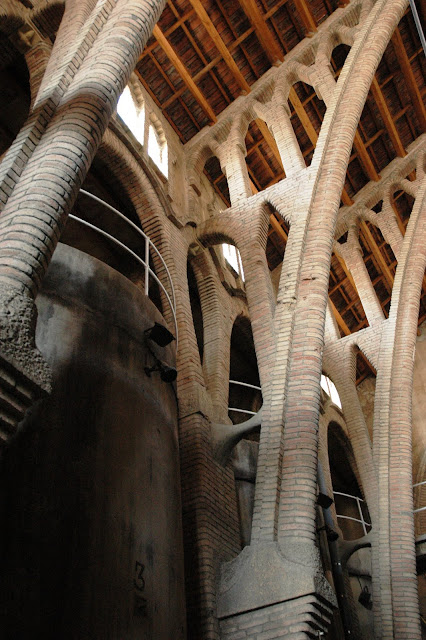In 1979 Carlos Esteva decided to buy from his brother and sister the part he did not own of his grandfather’s run-down estate, Can Ráfols dels Caus. Moreover, he intended to live there and start a winery.
The estate, located in the Garraf massif in the southern part of the Penedès DO, had come a long way, with evidence of winemaking since Iberian and Roman times, and being documented as early as the 11th century. In the hands of the Ráfols-Caus family since the 16th century, it had passed into the Estevas after the ruin of the former. It has some 500 hectares, 50 of which grow vines.
Already in the beginning Carlos was revolutionary in many ways. He was among the first in planting many different, often foreign, grape varieties, and tying them up in trellises instead of letting them grow as bushes. There were plenty of opportunities to match the particular features of the vineyard and the needs of the specific grape variety. The Garraf is a hilly stretch between the plain of Penedès and the sea; in fact, a huge limestone carved by millennia of water erosion offering a choice of vineyards with a shallow soil layer. Soils are poor, and Dolomitic fossils and limestone prevail, adding a touch of minerality to most wines; in zones closer to the plain, more clay can be found. Average elevation is ca. 300 meters, and the closeness of the sea, which can be seen from some vineyards, helps to cool down and dampen the hot summer afternoons, helping the ripening process.
Farming processes are ecological, with no use of herbicides or insecticides. From 2011 on they will be certified by the Catalan Council for Ecological Production (CCPAE). They respect the local herbaceous flora, which helps to fix the thin soil layer, and the local insect fauna, to better control potential pests. In some vineyards and wines they also apply biodynamic principles.
 |
| The top of the new winery |
The wonderfully refurbished country house and premises, where for many years wine was made, are now replaced by a brand new winery, built into the mountain after carving a huge hole in the limestone, and covered again with soil where the normal vegetation grows again; from afar, only the glass windows scattered among olive trees, aromatic shrubs and pines hint at the structure below.
 |
| The Moria gate |
Underground, after having passed through a 5-ton stone gate worthy of an entrance to the Moria mines, limestone, concrete, steel and glass dominate in a winery designed with open kitchens in mind: all activities can be seen by visitors with the natural light coming from the ceiling. The latest technology is available, combined with intelligent use of gravity to minimize pumping. In the end of the cave, barrels and bottles bide their time.
In this state-of-the-art equipment grapes from different plots are processed separately. Most of the grapes are hand picked and many selected in the vine. Fermentation comes from yeasts naturally occurring in the grapes.
Can Ráfols dels Caus grow up to 20 grape varieties, including some quite rare in Penedès: Pinot Noir, Caladoc, Incroccio Manzoni, Chenin Blanc, Marsanne.
Wines from this winery are typically balanced and elegant. Very few (perhaps only Caus Lubis) have the enormous structure and tannins frequent in other wines of nearby zones.
We can pick four groups of wines:
The Petit Caus range (white, rosé, red) includes wines for everyday consumption, easy to drink, and each normally coming from several grape varieties.
Under the Gran Caus label we find also white, rosé and red. The white is a blend of Xarel.lo, Chardonnay and Chenin, with no oak ageing. The rosé, the best in Catalunya imho, is a single Merlot with rich fruit, body and a refreshing acidity. The red Gran Caus is a “Bordeaux blend” of Cabernet Franc, Merlot and Cabernet Sauvignon. After 12 months in Allier oak and ca. 4 years in the bottle (most Caus wines leave the winery ready to drink) the wine is round, elegant, with fruity and balsamic notes, making it a very versatile wine to match most types of food.
There is a third group: the monovarietals. Some very special wines here.
Xarel.lo Pairal comes from 60 year old vines and is fermented in traditional chestnut barrels, that have less impact than oak.
 |
| The chestnut barrels |
El Rocallís comes from the plot of this name, planted with Incroccio Manzoni, a crossing of Riesling and Pinot Blanc. The complexity of floral and fruity aromas is surprising.
 |
| El Rocallis |
La Calma is a Chenin Blanc with the richness and opulence typical of this grape.
Caus Lubis, named after a Roman wine produced in this zone, is probably the best Merlot in Catalonia. Full bodied and fruity (blackberries) after 12 months in Allier oak and 4 years in the bottle.
Ad Fines is one of the rare Pinot Noirs grown in Catalonia. It is no secret that this is a difficult grape to work with, even in its native Burgundy. To grow it here, in the limit of its potential area (that is what Ad Fines means in Latin) is a juggling act in which Carlos Esteva succeeds most of the years.
Last but not least, Can Ráfols dels Caus, as many other wineries in Penedès, produces also Cava. Two Gran Caus, white (mainly Chardonnay) and rosé (mainly Pinot Noir), and white Parisad (again Chardonnay). These are all Gran Reserva, with at least 3 years of bottle aging (10 for Parisad, which is also fermented in Allier oak). They are complex, with small and persistent bubble, and can match perfectly a full meal.
 |
| Some fond memories |
I have been an eager drinker of these wines for a long time. Each of them offers something different from other wines. Only recently have I visited their premises and understood what is underneath. I should have done so much earlier...
http://www.canrafolsdelscaus.com/en/


























